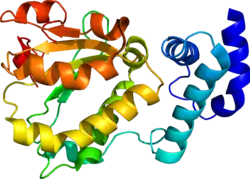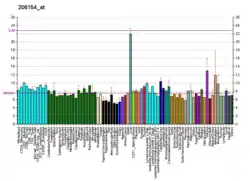Retinaldehyde-binding protein 1
Retinaldehyde-binding protein 1 (RLBP1) also known as cellular retinaldehyde-binding protein (CRALBP) is a 36-kD water-soluble protein that in humans is encoded by the RLBP1 gene.[5][6][7]
| RLBP1 | |||||||||||||||||||||||||
|---|---|---|---|---|---|---|---|---|---|---|---|---|---|---|---|---|---|---|---|---|---|---|---|---|---|
 | |||||||||||||||||||||||||
| |||||||||||||||||||||||||
| Identifiers | |||||||||||||||||||||||||
| Aliases | RLBP1, CRALBP, retinaldehyde binding protein 1 | ||||||||||||||||||||||||
| External IDs | OMIM: 180090 MGI: 97930 HomoloGene: 68046 GeneCards: RLBP1 | ||||||||||||||||||||||||
| |||||||||||||||||||||||||
| |||||||||||||||||||||||||
| |||||||||||||||||||||||||
| |||||||||||||||||||||||||
| Orthologs | |||||||||||||||||||||||||
| Species | Human | Mouse | |||||||||||||||||||||||
| Entrez | |||||||||||||||||||||||||
| Ensembl | |||||||||||||||||||||||||
| UniProt | |||||||||||||||||||||||||
| RefSeq (mRNA) | |||||||||||||||||||||||||
| RefSeq (protein) | |||||||||||||||||||||||||
| Location (UCSC) | Chr 15: 89.21 – 89.22 Mb | Chr 7: 79.37 – 79.39 Mb | |||||||||||||||||||||||
| PubMed search | [3] | [4] | |||||||||||||||||||||||
| Wikidata | |||||||||||||||||||||||||
| |||||||||||||||||||||||||
Discovery
Cellular retinol binding protein (CRBP) was first discovered in 1973 from lung tissues by Bashor et al.[8] There have been three cellular retinol binding protein categories discovered; Cellular retinol-binding protein, cellular retinoic acid-binding protein and cellular retinaldehyde-binding protein(CRALBP).[8][9][10] CRALBP was first discovered in 1977, after it was purified from retina and retinal pigment epithelial cells.[10][11]
Function
The cellular retinaldehyde-binding protein transports 11-cis-retinal (also known as 11-cis-retinaldehyde) as its physiological ligands. It plays a critical role as an 11-cis-retinal acceptor which facilitates the enzymatic isomerization of all 11-trans-retinal to 11-cis-retinal, in the isomerization of the rod and cones of the visual cycle.[12][13]
Tissue distribution
CRALBP is not just found in retina and retinal pigment epithelial cells, but also expressed in other cell types. It is majorly found in the iris, cornea, ciliary epithelium, Muller cells, the pineal gland and oligodendrocytes of the optic nerve and brain. This protein is also found in other tissues than the aforementioned ones, however its function in cells not related to the eyes are not yet known [14]
Clinical significance
When a visual pigment molecule in photoreceptors of mammalian rod and cone cells are triggered by photons of light, the pigment molecule is unable to detect an ensuing photon of light. All the retinal molecules in the chromophore of the visual pigment molecule, exist in the 11-trans-retinal state after stimulation by photons. RLBP1 helps in converting the 11-trans-retinal to the light sensitive 11-cis retinal. This process is a part of the visual cycle, which involves the expulsion of all 11-trans-retinal containing chromophores out of photoreceptors, and subsequent conversion to the 11-cis-retinal state in retinal pigment epithelial cells, for both rod and cone cells. The 11-cis chromophore is then signalled back into photoreceptor cells, where it undergoes fusion with a free opsin molecule to regenerate the visual pigment.[15][16][13]
Gene location
The RLBP1 gene is located on human chromosome 15, specifically on 15q26. This gene was formerly believed to have 8 exons and 7 introns.[5][17] However, Vogel et al. demonstrated that there are actually 8 introns on that chromosome.[18] A gene element, upstream of the previously thought exon 1 was originally thought to be an enhancer. In reality, this assumed enhancer is the main promoter for this gene. The newly discovered intron 1 lies within and just near the end of the promoter region of RLBP1 gene.[18]
Mutations and associated diseases
Mutations of RLBP1 include several diseases associated with vision. All of these are autosomal recessive including Bothnia dystrophy, retinitis punctata albescens, retinitis pigmentosa, Newfoundland rod-cone dystrophy and fundus albipunctatus. The characteristics of the associated diseases vary with age, severity and rate of progression. These all have similar qualities such as, photoreceptor deterioration and slower dark adaptation, ultimately leading to visual impairment, often leading to complete blindness.[14]
Bothnia dystrophy
People suffering from Bothnia dystrophy have a homozygous C to T base pair substitution in exon 7 of the RLBP1 gene. This leads to a missense mutation from Arginine to Tryptophan at the 234 position of the RLBP1.[19]
Retinitis punctata albescens and fundus albipunctatus
Katsanis et al. showed that a homozygous alteration from Arginine to Glutamine amino acid expression, at the 150 position on RLBP1, brings about the onset of retinitis punctata albescens and or fundus albipunctatus.[20]
References
- GRCh38: Ensembl release 89: ENSG00000140522 - Ensembl, May 2017
- GRCm38: Ensembl release 89: ENSMUSG00000039194 - Ensembl, May 2017
- "Human PubMed Reference:". National Center for Biotechnology Information, U.S. National Library of Medicine.
- "Mouse PubMed Reference:". National Center for Biotechnology Information, U.S. National Library of Medicine.
- Sparkes RS, Heinzmann C, Goldflam S, Kojis T, Saari JC, Mohandas T, Klisak I, Bateman JB, Crabb JW (January 1992). "Assignment of the gene (RLBP1) for cellular retinaldehyde-binding protein (CRALBP) to human chromosome 15q26 and mouse chromosome 7". Genomics. 12 (1): 58–62. doi:10.1016/0888-7543(92)90406-I. PMID 1733864.
- Maw MA, Kennedy B, Knight A, Bridges R, Roth KE, Mani EJ, Mukkadan JK, Nancarrow D, Crabb JW, Denton MJ (October 1997). "Mutation of the gene encoding cellular retinaldehyde-binding protein in autosomal recessive retinitis pigmentosa". Nature Genetics. 17 (2): 198–200. doi:10.1038/ng1097-198. PMID 9326942.
- "Entrez Gene: RLBP1 retinaldehyde binding protein 1".
- Bashor MM, Toft DO, Chytil F (December 1973). "In vitro binding of retinol to rat-tissue components". Proceedings of the National Academy of Sciences of the United States of America. 70 (12): 3483–7. doi:10.1073/pnas.70.12.3483. PMC 427264. PMID 4519641.
- Saari JC, Bredberg L, Garwin GG (November 1982). "Identification of the endogenous retinoids associated with three cellular retinoid-binding proteins from bovine retina and retinal pigment epithelium". The Journal of Biological Chemistry. 257 (22): 13329–33. PMID 6292186.
- Futterman S, Saari JC (August 1977). "Occurrence of 11-cis-retinal-binding protein restricted to the retina". Investigative Ophthalmology & Visual Science. 16 (8): 768–71. PMID 560359.
- Stubbs GW, Saari JC, Futterman S (September 1979). "11-cis-Retinal-binding protein from bovine retina. Isolation and partial characterization". The Journal of Biological Chemistry. 254 (17): 8529–33. PMID 468840.
- Saari JC, Nawrot M, Kennedy BN, Garwin GG, Hurley JB, Huang J, Possin DE, Crabb JW (March 2001). "Visual cycle impairment in cellular retinaldehyde binding protein (CRALBP) knockout mice results in delayed dark adaptation". Neuron. 29 (3): 739–48. doi:10.1016/S0896-6273(01)00248-3. PMID 11301032.
- Xue Y, Shen SQ, Jui J, Rupp AC, Byrne LC, Hattar S, Flannery JG, Corbo JC, Kefalov VJ (February 2015). "CRALBP supports the mammalian retinal visual cycle and cone vision". The Journal of Clinical Investigation. 125 (2): 727–38. doi:10.1172/JCI79651. PMC 4319437. PMID 25607845.
- Kennedy BN, Li C, Ortego J, Coca-Prados M, Sarthy VP, Crabb JW (February 2003). "CRALBP transcriptional regulation in ciliary epithelial, retinal Müller and retinal pigment epithelial cells". Experimental Eye Research. 76 (2): 257–60. doi:10.1016/s0014-4835(02)00308-1. PMID 12565814.
- Saari JC (August 2012). "Vitamin A metabolism in rod and cone visual cycles". Annual Review of Nutrition. 32: 125–45. doi:10.1146/annurev-nutr-071811-150748. PMID 22809103.
- Wang JS, Kefalov VJ (March 2011). "The cone-specific visual cycle". Progress in Retinal and Eye Research. 30 (2): 115–28. doi:10.1016/j.preteyeres.2010.11.001. PMC 3073571. PMID 21111842.
- Intres R, Goldflam S, Cook JR, Crabb JW (October 1994). "Molecular cloning and structural analysis of the human gene encoding cellular retinaldehyde-binding protein". The Journal of Biological Chemistry. 269 (41): 25411–8. PMID 7929238.
- Vogel JS, Bullen EC, Teygong CL, Howard EW (August 2007). "Identification of the RLBP1 gene promoter". Investigative Ophthalmology & Visual Science. 48 (8): 3872–7. doi:10.1167/iovs.06-1523. PMID 17652763.
- Burstedt MS, Sandgren O, Holmgren G, Forsman-Semb K (April 1999). "Bothnia dystrophy caused by mutations in the cellular retinaldehyde-binding protein gene (RLBP1) on chromosome 15q26". Investigative Ophthalmology & Visual Science. 40 (5): 995–1000. PMID 10102298.
- Katsanis N, Shroyer NF, Lewis RA, Cavender JC, Al-Rajhi AA, Jabak M, Lupski JR (June 2001). "Fundus albipunctatus and retinitis punctata albescens in a pedigree with an R150Q mutation in RLBP1". Clinical Genetics. 59 (6): 424–9. doi:10.1034/j.1399-0004.2001.590607.x. PMID 11453974.
Further reading
- Crabb JW, Goldflam S, Harris SE, Saari JC (December 1988). "Cloning of the cDNAs encoding the cellular retinaldehyde-binding protein from bovine and human retina and comparison of the protein structures". The Journal of Biological Chemistry. 263 (35): 18688–92. PMID 3198595.
- Dunn KC, Aotaki-Keen AE, Putkey FR, Hjelmeland LM (February 1996). "ARPE-19, a human retinal pigment epithelial cell line with differentiated properties". Experimental Eye Research. 62 (2): 155–69. doi:10.1006/exer.1996.0020. PMID 8698076.
- Bonaldo MF, Lennon G, Soares MB (September 1996). "Normalization and subtraction: two approaches to facilitate gene discovery". Genome Research. 6 (9): 791–806. doi:10.1101/gr.6.9.791. PMID 8889548.
- Sarthy V (December 1996). "Cellular retinaldehyde-binding protein localization in cornea". Experimental Eye Research. 63 (6): 759–62. doi:10.1006/exer.1996.0170. PMID 9068383.
- Crabb JW, Carlson A, Chen Y, Goldflam S, Intres R, West KA, Hulmes JD, Kapron JT, Luck LA, Horwitz J, Bok D (March 1998). "Structural and functional characterization of recombinant human cellular retinaldehyde-binding protein". Protein Science. 7 (3): 746–57. doi:10.1002/pro.5560070324. PMC 2143945. PMID 9541407.
- Burstedt MS, Sandgren O, Holmgren G, Forsman-Semb K (April 1999). "Bothnia dystrophy caused by mutations in the cellular retinaldehyde-binding protein gene (RLBP1) on chromosome 15q26". Investigative Ophthalmology & Visual Science. 40 (5): 995–1000. PMID 10102298.
- Morimura H, Berson EL, Dryja TP (April 1999). "Recessive mutations in the RLBP1 gene encoding cellular retinaldehyde-binding protein in a form of retinitis punctata albescens". Investigative Ophthalmology & Visual Science. 40 (5): 1000–4. PMID 10102299.
- Thumann G, Kociok N, Bartz-Schmidt KU, Esser P, Schraermeyer U, Heimann K (December 1999). "Detection of mRNA for proteins involved in retinol metabolism in iris pigment epithelium". Graefe's Archive for Clinical and Experimental Ophthalmology. 237 (12): 1046–51. doi:10.1007/s004170050343. PMID 10654176.
- Burstedt MS, Forsman-Semb K, Golovleva I, Janunger T, Wachtmeister L, Sandgren O (February 2001). "Ocular phenotype of bothnia dystrophy, an autosomal recessive retinitis pigmentosa associated with an R234W mutation in the RLBP1 gene". Archives of Ophthalmology. 119 (2): 260–7. PMID 11176989.
- Harrington JJ, Sherf B, Rundlett S, Jackson PD, Perry R, Cain S, Leventhal C, Thornton M, Ramachandran R, Whittington J, Lerner L, Costanzo D, McElligott K, Boozer S, Mays R, Smith E, Veloso N, Klika A, Hess J, Cothren K, Lo K, Offenbacher J, Danzig J, Ducar M (May 2001). "Creation of genome-wide protein expression libraries using random activation of gene expression". Nature Biotechnology. 19 (5): 440–5. doi:10.1038/88107. PMID 11329013.
- Katsanis N, Shroyer NF, Lewis RA, Cavender JC, Al-Rajhi AA, Jabak M, Lupski JR (June 2001). "Fundus albipunctatus and retinitis punctata albescens in a pedigree with an R150Q mutation in RLBP1". Clinical Genetics. 59 (6): 424–9. doi:10.1034/j.1399-0004.2001.590607.x. PMID 11453974.
- Eichers ER, Green JS, Stockton DW, Jackman CS, Whelan J, McNamara JA, Johnson GJ, Lupski JR, Katsanis N (April 2002). "Newfoundland rod-cone dystrophy, an early-onset retinal dystrophy, is caused by splice-junction mutations in RLBP1". American Journal of Human Genetics. 70 (4): 955–64. doi:10.1086/339688. PMC 379124. PMID 11868161.
- Golovleva I, Bhattacharya S, Wu Z, Shaw N, Yang Y, Andrabi K, West KA, Burstedt MS, Forsman K, Holmgren G, Sandgren O, Noy N, Qin J, Crabb JW (April 2003). "Disease-causing mutations in the cellular retinaldehyde binding protein tighten and abolish ligand interactions". The Journal of Biological Chemistry. 278 (14): 12397–402. doi:10.1074/jbc.M207300200. PMID 12536144.
- Wu Z, Yang Y, Shaw N, Bhattacharya S, Yan L, West K, Roth K, Noy N, Qin J, Crabb JW (April 2003). "Mapping the ligand binding pocket in the cellular retinaldehyde binding protein". The Journal of Biological Chemistry. 278 (14): 12390–6. doi:10.1074/jbc.M212775200. PMID 12536149.
- Fishman GA, Roberts MF, Derlacki DJ, Grimsby JL, Yamamoto H, Sharon D, Nishiguchi KM, Dryja TP (January 2004). "Novel mutations in the cellular retinaldehyde-binding protein gene (RLBP1) associated with retinitis punctata albescens: evidence of interfamilial genetic heterogeneity and fundus changes in heterozygotes". Archives of Ophthalmology. 122 (1): 70–5. doi:10.1001/archopht.122.1.70. PMID 14718298.
- Nawrot M, West K, Huang J, Possin DE, Bretscher A, Crabb JW, Saari JC (February 2004). "Cellular retinaldehyde-binding protein interacts with ERM-binding phosphoprotein 50 in retinal pigment epithelium". Investigative Ophthalmology & Visual Science. 45 (2): 393–401. doi:10.1167/iovs.03-0989. PMID 14744877.




